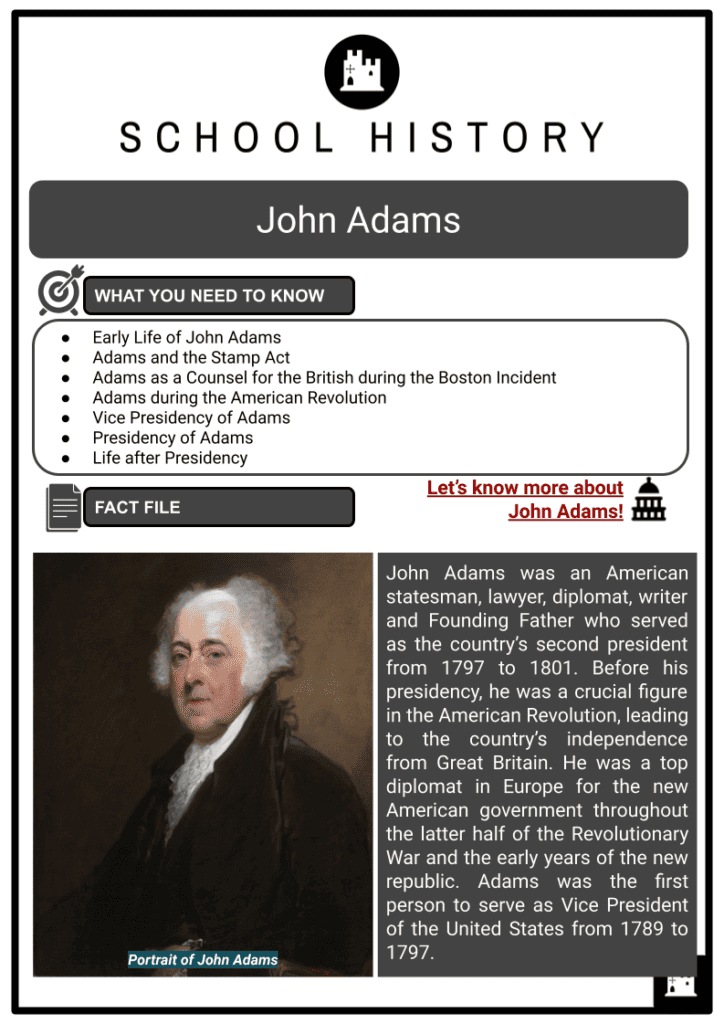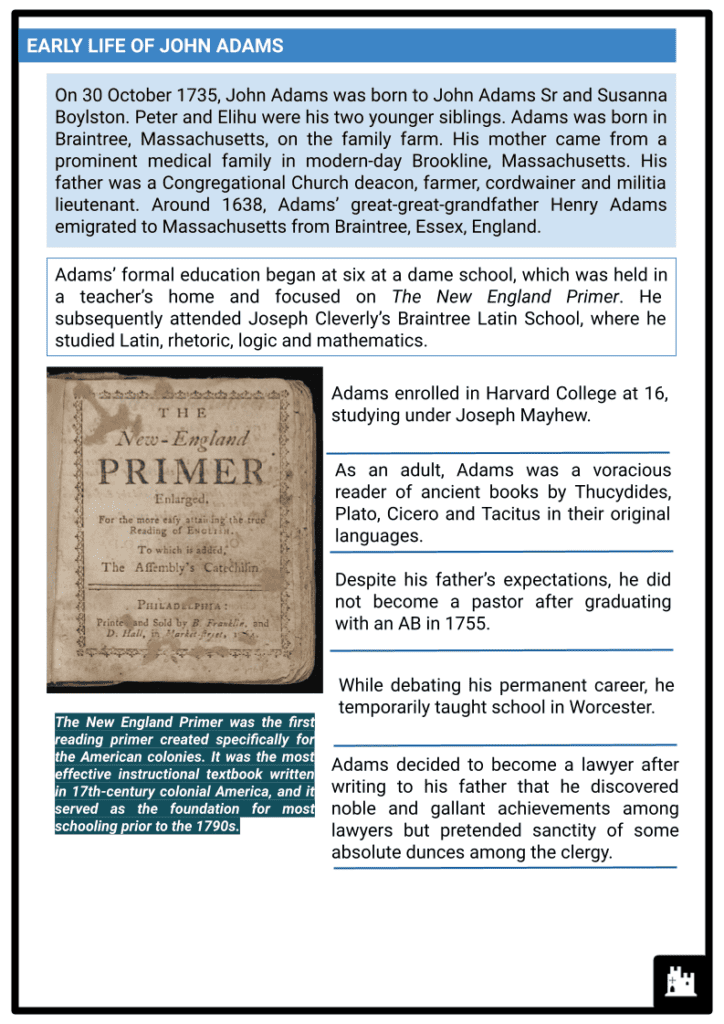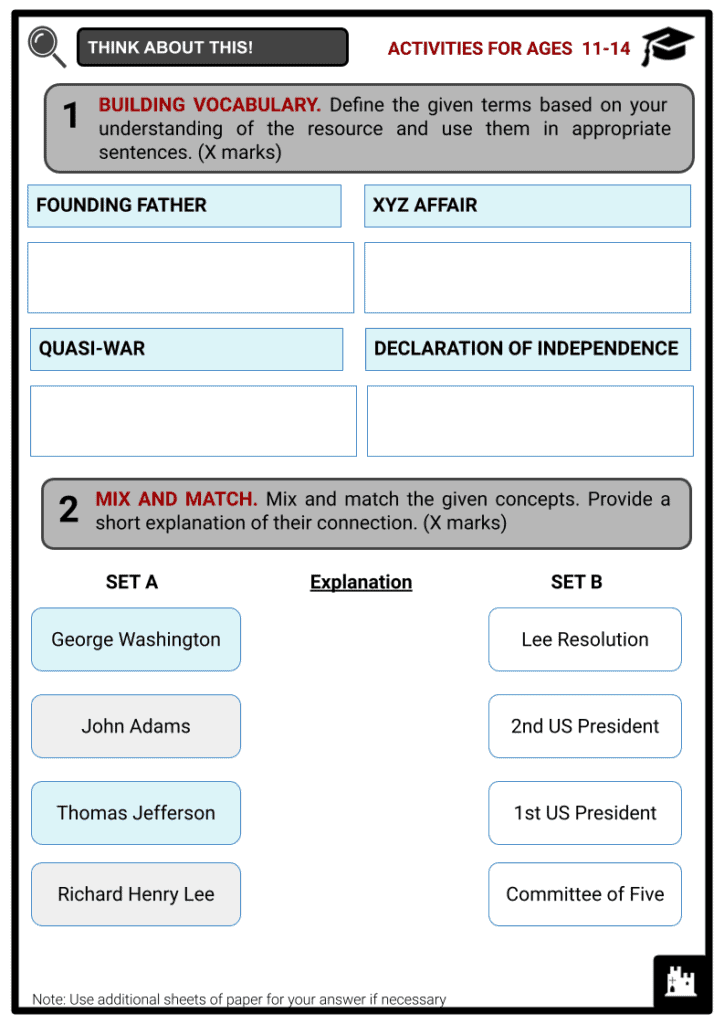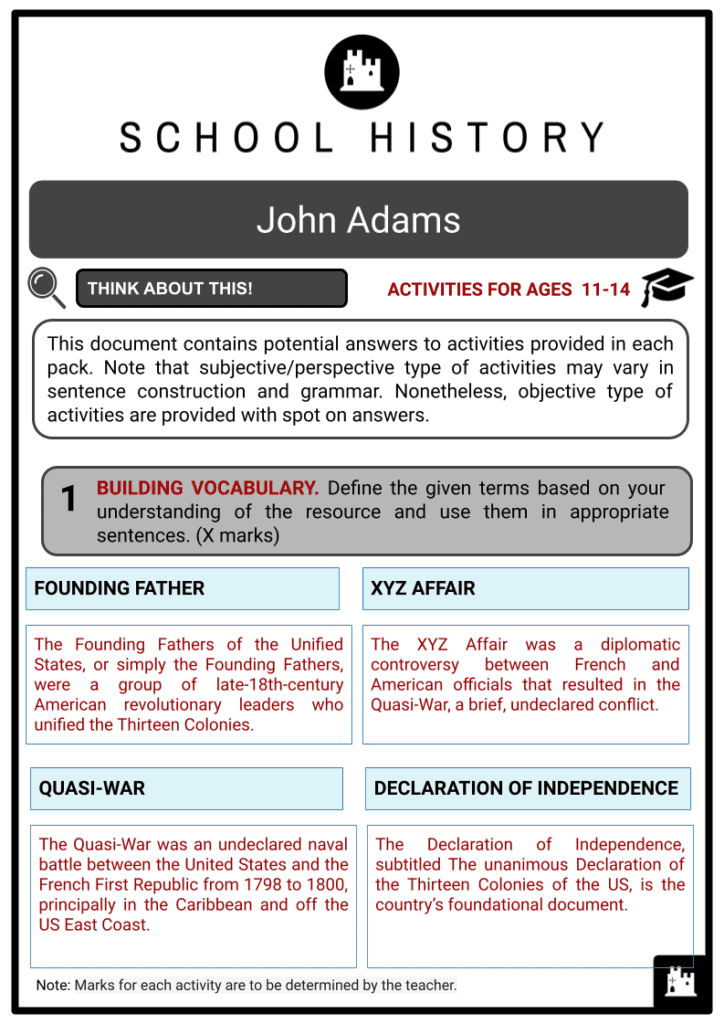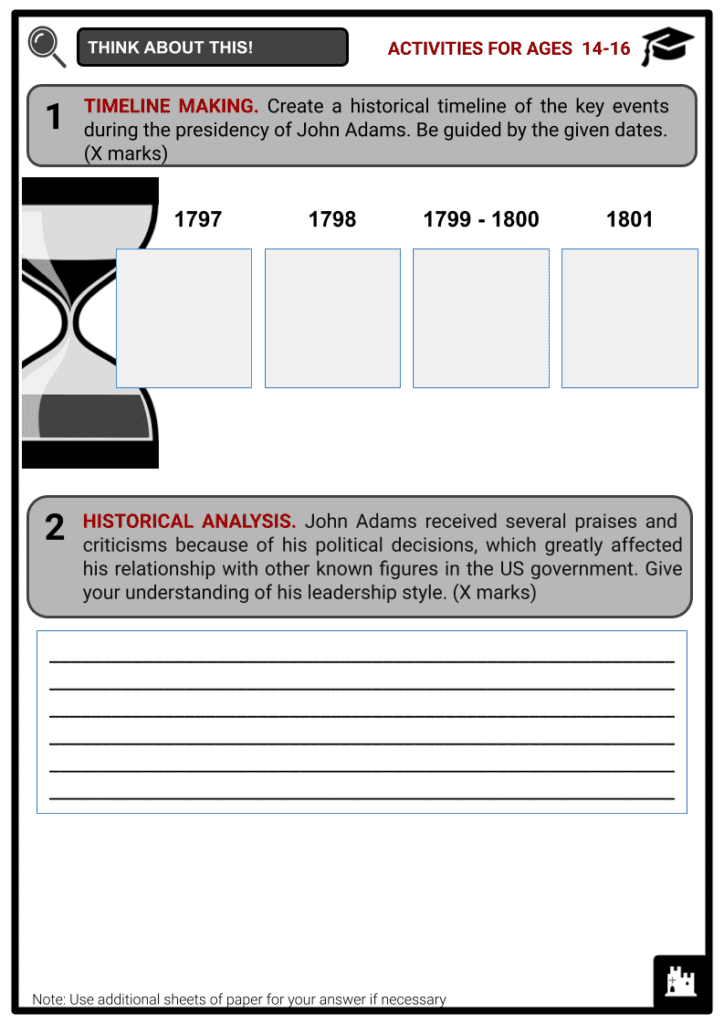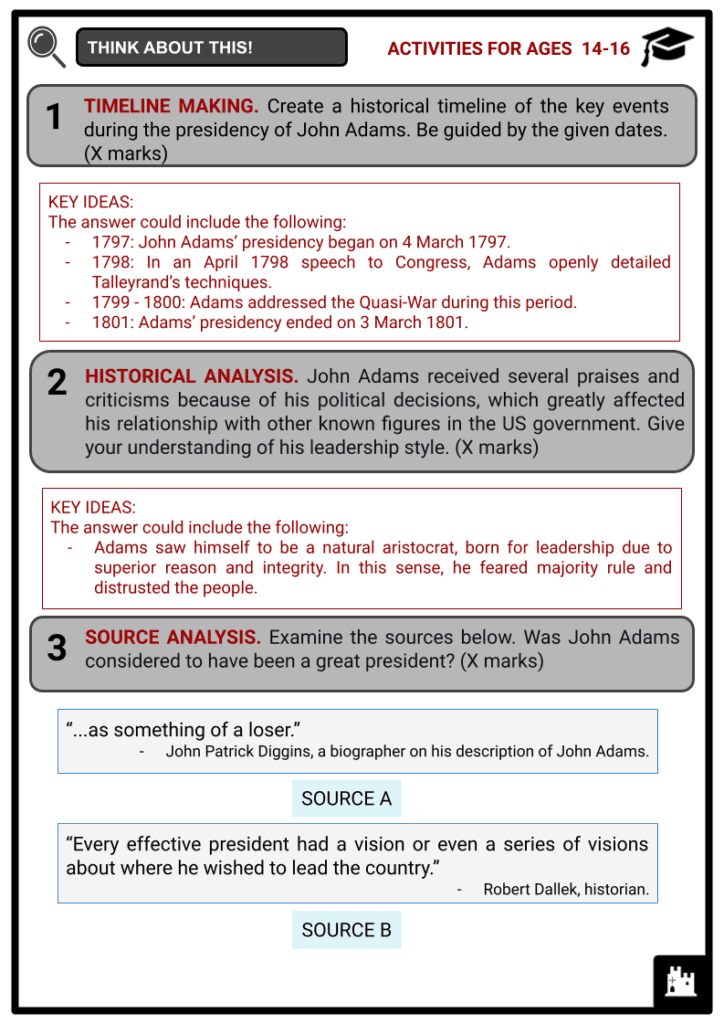John Adams Worksheets
Do you want to save dozens of hours in time? Get your evenings and weekends back? Be able to teach about John Adams to your students?
Our worksheet bundle includes a fact file and printable worksheets and student activities. Perfect for both the classroom and homeschooling!
Summary
- Early Life of John Adams
- Adams and the Stamp Act
- Adams as a Counsel for the British during the Boston Incident
- Adams during the American Revolution
- Vice Presidency of Adams
- Presidency of Adams
- Life after Presidency
Key Facts And Information
Let’s know more about John Adams!
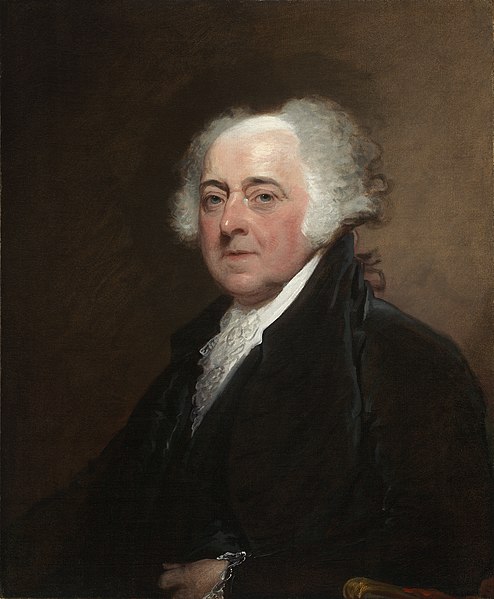
John Adams was an American statesman, lawyer, diplomat, writer and Founding Father who served as the country’s second president from 1797 to 1801. Before his presidency, he was a crucial figure in the American Revolution, leading to the country’s independence from Great Britain. He was a top diplomat in Europe for the new American government throughout the latter half of the Revolutionary War and the early years of the new republic. Adams was the first person to serve as Vice President of the United States from 1789 to 1797.
EARLY LIFE OF JOHN ADAMS
- On 30 October 1735, John Adams was born to John Adams Sr and Susanna Boylston. Peter and Elihu were his two younger siblings. Adams was born in Braintree, Massachusetts, on the family farm. His mother came from a prominent medical family in modern-day Brookline, Massachusetts. His father was a Congregational Church deacon, farmer, cordwainer and militia lieutenant. Around 1638, Adams’ great-great-grandfather Henry Adams emigrated to Massachusetts from Braintree, Essex, England.
- Adams’ formal education began at six at a dame school, which was held in a teacher’s home and focused on The New England Primer. He subsequently attended Joseph Cleverly’s Braintree Latin School, where he studied Latin, rhetoric, logic and mathematics.
- Adams enrolled in Harvard College at 16, studying under Joseph Mayhew.
- As an adult, Adams was a voracious reader of ancient books by Thucydides, Plato, Cicero and Tacitus in their original languages.
- Despite his father’s expectations, he did not become a pastor after graduating with an AB in 1755.
- While debating his permanent career, he temporarily taught school in Worcester.
- Adams decided to become a lawyer after writing to his father that he discovered noble and gallant achievements among lawyers but pretended sanctity of some absolute dunces among the clergy.
Adams during his early legal practice and marriage life
1756
- Adams started his apprenticeship under James Putnam, a leading lawyer in Worcester.
1758
- He earned a degree of Master of Arts from Harvard.
1759
- Adams was admitted to the bar.
- He met his third cousin, 15-year-old Abigail Smith, through his friend Richard Cranch, who was pursuing Abigail’s older sister.
1764
- Despite Abigail’s mother’s reluctance, they married on 25 October 1764.
ADAMS AND THE STAMP ACT
- Adams gained prominence as a leader of the Stamp Act opposition. The British Parliament enacted the act without consulting the American legislatures. It forced the colonies to pay a direct tax on stamped documents to cover the costs of Britain’s war with France. Instead of ordinary law courts, British vice-admiralty courts were given enforcement authority.
- The act was reviled for its monetary cost and adoption without a colonial agreement, and it met with violent opposition, blocking its enforcement.
- Adams wrote the Braintree Instructions in a letter to the Braintree delegates in the Massachusetts legislature in 1765. The Braintree Instructions explained that the Stamp Act should be resisted because it violated two fundamental rights granted to all Englishmen: the right to be taxed only by consent and the right to be tried before a jury of one’s peers.
- Adams also spoke before the governor and council in December 1765, declaring the Stamp Act unconstitutional without Massachusetts representation in Parliament. He noted that numerous protests were spurred by Boston clergyman Jonathan Mayhew’s renowned sermon, in which he invoked Romans 13 to advocate revolt.
- While Adams wrote forcefully against the act, he refused attempts by Samuel Adams, a leader in popular movements, to include him in mob activities and public protests. Braintree’s town meeting chose John Adams as a selectman in 1766.
- Tensions with Britain briefly eased after the Stamp Act was repealed in early 1766. Aside from politics, Adams relocated his family to Boston in April 1768 to concentrate on his law practice.
- The family rented a residence on Brattle Street, known as the White House by the locals. He, Abigail and the children resided there for a year before moving to Cold Lane and subsequently to a larger house in Brattle Square in the city centre.
ADAMS AS A COUNSEL FOR THE BRITISH DURING THE BOSTON INCIDENT
- Britain’s enactment of the Townshend Acts in 1767 reignited tensions, and increased mob violence prompted the British to send more troops to the colonies. When a mob approached a lone British sentry on 5 March 1770, eight of his fellow troops reinforced him, and the gathering around them expanded to several hundred people. The Townshend Acts were a set of British acts of Parliament passed between 1767 and 1768 that established a set of taxes and rules to fund the administration of the British colonies in America.
- Snowballs, ice and stones were thrown at the soldiers, and in the ensuing commotion, the soldiers opened fire, killing five citizens in the historic Boston Massacre. The suspected soldiers were arrested on murder charges.
- When no other lawyers would defend them, Adams felt compelled to do so despite the risk to his reputation. He felt that no one should be denied counsel or a fair trial.
- Captain Thomas Preston’s week-long trial began on 24 October and ended with his acquittal due to the inability to establish that he instructed his soldiers to fire.
- The remaining troops were tried in December, and Adams delivered his famous argument on jury decisions:
- Six of the troops were acquitted by Adams.
- This exposure improved the success of his law practice and the demands on his time.
“Facts are stubborn things, and whatever may be our wishes, our inclinations, or the dictates of our passion, they cannot alter the state of facts and evidence.”
ADAMS DURING THE AMERICAN REVOLUTION
- Adams, one of the more conservative Founding Fathers, was adamant that, while British actions against the colonies were wrong, open insurrection was unjustified and that a peaceful petition to stay a part of Great Britain was better. The Founding Fathers were a group of late-19th-century American revolutionary leaders who united the Thirteen Colonies, oversaw the War of Independence from Great Britain, established the United States (US), and crafted a government framework for the new nation.
- Adams’ views began to shift in 1772 when the British Crown seized responsibility for paying the salaries of Governor Thomas Hutchinson and his justices rather than the Massachusetts assembly. In the Gazette, Adams stated that these measures would weaken judicial independence and bring the colonial government closer to the Crown. After members of the legislature expressed dissatisfaction, Hutchinson issued a speech warning that Parliament’s rights over the colonies were absolute and that any resistance was unlawful.
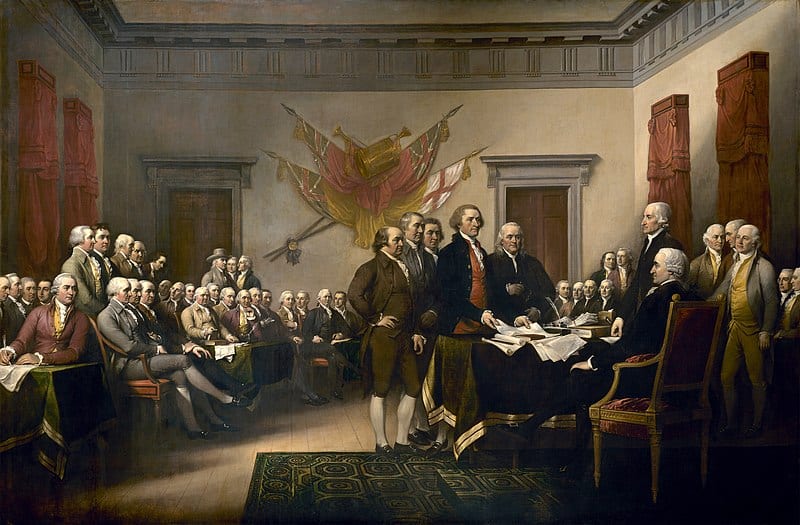
As represented in John Trumbull’s 1819 image, the Committee of Five (Adams, Livingston, Sherman, Jefferson and Franklin) present their draft of the Declaration of Independence to the Second Continental Congress in Philadelphia on 28 June 1776. - The resolution claimed that the colonists had never been subject to Parliament’s sovereignty: their charter and allegiance belonged only to the King.
- The Boston Tea Party took place on 16 December 1773 as a protest over the British East India Company’s tea monopoly over American merchants and the Tea Act.
- Protesters destroyed 342 chests of tea valued at around 10,000 pounds aboard the British vessel Dartmouth, which was docked in Boston harbour. The Dartmouth owners briefly retained Adams as legal counsel over their liability for the wrecked shipment.
Declaration of Independence
- Throughout the first half of 1776, Adams became more frustrated with what he saw as the glacial pace of proclaiming independence. He helped push through a plan to prepare armed ships to raid enemy vessels at the Second Continental Congress in Philadelphia. Later that year, he developed the provisional navy’s first set of regulations.
- Adams wrote the preamble known as the Lee Resolution of his colleague Richard Henry Lee. He struck up a friendship with Virginia delegate Thomas Jefferson, who had been sluggish to favour independence but had come around by early 1776. The Lee Resolution was the formal declaration made by the Second Continental Congress on 2 July 1776 that the Thirteen Colonies, then known as the United Colonies, were free and independent States separate from the British Empire, resulting in the formation of the United States of America. Along with the subject of independence, it advocated establishing a strategy for future American international relations and preparing a confederation plan for the states to consider.
- Before declaring independence, Adams formed a Committee of Five to craft a Declaration of Independence. Adams, along with Thomas Jefferson, Benjamin Franklin, Robert R Livingston and Roger Sherman, comprised the Committee of Five.
- Adams thought Jefferson should draft the document, but Adams persuaded the committee to choose Jefferson.
“Reason first, you are a Virginian and a Virginian ought to appear at the head of this business. Reason second, I am obnoxious, suspected, and unpopular. You are very much otherwise. Reason third, you can write ten times better than I can.”
- Although Jefferson wrote the first draft substantially, Adams made a significant impact. The resolution was debated in Congress on 1 July. It was expected to pass, but opponents like John Dickinson made a concerted attempt to stop it. On 2 July, Congress adopted the document after further revision. Twelve colonies voted in favour, but New York voted no.
Adams as the Head of Board of War and Ordnance
- Adams was appointed to the Board of War and Ordnance, which recorded the officers in the army and their ranks, troop placement throughout the provinces, and ammunition. Adams served as de facto Secretary of War.
- He was the author of the Plan of Treaties, which outlined Congress’ prerequisites for a treaty with France. British Admiral Richard Howe perceived a strategic advantage after winning against the Continental Army at the Battle of Long Island on 27 August 1776. He requested that Congress send representatives to discuss peace.
- On 11 September, with Franklin and Edward Rutledge, Adams met with Howe at the Staten Island Peace Conference. The parties could not find common ground because Howe’s authority was based on the states’ submission.
Adams and the Treaty of Paris
- After negotiating the loan with the Dutch, Adams was reappointed as the American commissioner to negotiate the Treaty of Paris, which ended the war.
- Because Vergennes and France’s minister to the United States, Anne-César de La Luzerne, rejected Adams, Franklin, Thomas Jefferson, John Jay and Henry Laurens were chosen to collaborate with him. However, Jefferson did not initially travel to Europe, and Laurens was assigned to the Dutch Republic following his detention in the Tower of London.
- In the final negotiations, obtaining fishing rights off Newfoundland and Cape Breton Island proved crucial and challenging. In reaction to the British’s tight limitations, Adams urged that not only should American fishermen be permitted to travel as close to shore as they wanted, but they should also be able to fish on the shores of Newfoundland.
- Jay and Adams opted to bypass France and engage directly with the British, overruling Franklin and distrusting Vergennes. During these negotiations, Adams informed the British that his proposed fishing terms were more liberal than France’s in 1778 and that agreeing would create goodwill between the United Kingdom and the US while putting pressure on France.
- Britain accepted, and the two parties worked out the other details later. Vergennes was enraged when he learnt of American dishonesty through Franklin but did not demand renegotiation. He was taken aback by how much the Americans could obtain.
- Because of the independent negotiations, the French could claim innocence from their Spanish allies, whose demands for Gibraltar could have posed considerable issues. The pact was signed on 3 September 1783, and American independence was recognised.
VICE PRESIDENCY OF JOHN ADAMS
- George Washington was unanimously elected as the first president of the US in 1789. According to early protocol, the person with the most electoral votes would be nominated president, while the one with the second most would become vice president. On 13 April 1789, Adams left his hometown of Braintree for New York, where he would undertake the duties of vice president, second only to George Washington in authority.
Role of Adams as the Vice President
- The vice president’s sole constitutionally mandated function is to preside over the United States. They were given the authority to cast a tie-breaking vote in the Senate.
- Early in his presidency, Adams became embroiled in a lengthy Senate debate regarding the official titles for the new government’s president and executive offices.
- As Vice President, Adams mostly supported the Washington administration and the newly formed Federalist Party. Despite criticism from anti-Federalist Republicans, he supported Washington’s objectives.
- As Vice President, Adams played a minimal influence in politics. He rarely attended cabinet sessions, and the President rarely solicited his advice.
- The French Revolution began on 14 July 1789. Republicans were overjoyed. Adams began by expressing cautious hope but soon condemned the rebels as savage and despotic.
- Washington finally began to consult Adams more frequently, although not until near the conclusion of his presidency, when notable cabinet members Hamilton and Jefferson had resigned.
- The British had been plundering American commercial ships, so John Jay, governor of New York, was dispatched to London to broker a ceasefire. When Adams returned in 1795 with an unfavourable peace treaty to the United States, he encouraged Washington to ratify it to avoid war. This sparked protests and riots in Washington. He was accused of surrendering American honour to a totalitarian monarchy and abandoning the French Republic.
PRESIDENCY OF JOHN ADAMS
- The election of 1796 was the first disputed presidential election in the United States. George Washington had been elected to office overwhelmingly in the previous two elections. During his presidency, however, major philosophical differences emerged between the administration’s two leading figures – Alexander Hamilton and Thomas Jefferson.
- Their opposing views on home and foreign affairs prompted a schism within the administration, forming the Federalist Party and the Democratic-Republican Party. Washington’s revelation that he would not run for a third term sparked a fierce partisan battle for the presidency.
- In 1796, no candidates were directly presented to the voters, as in the previous two presidential elections. Instead, the Constitution stated that each state chooses presidential electors, and a vote of the presidential electors chooses the president.
- The Constitution stated that the person earning the most votes would be elected president if they received votes from a majority of electors, while the person receiving the second most electoral votes would be appointed vice president. In seven states, voters chose presidential electors.
- On 8 February 1797, the votes of the 138 members of the Electoral College were tabulated during a joint session of Congress. The top three vote recipients were Adams (71 votes), Jefferson (69 votes) and Thomas Pinckney (59 votes).
- The remaining votes were divided among Aaron Burr from the Democratic-Republican Party and nine other candidates. Almost all of Adams’ votes were cast by Northern electors, whereas almost all of Jefferson’s votes were cast by Southern electors.
- The American two-party system emerged in the run-up to the 1796 election, which was the first to elect a president and vice president from competing parties.
Cabinet of John Adams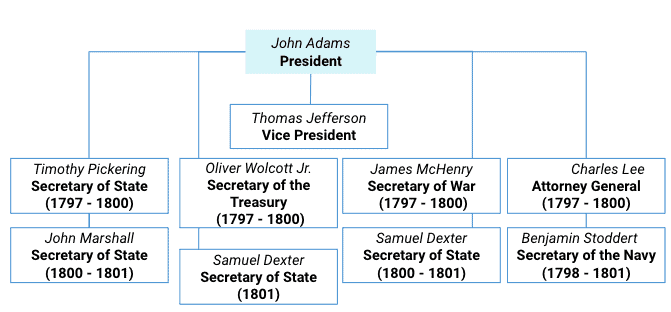
- Aside from the selection procedure, the Constitution merely made a fleeting mention of executive branch agency operations. The term cabinet was first applied to the leaders of executive branch departments late in Washington’s first term, and Washington depended on his cabinet as an advising council.
- While the Constitution clarified that those selected to manage these agencies reported to the president, it remained silent on how cabinet appointments could be terminated.
- When Adams took office, there was no precedent for the continuation of the former President’s top officers. Rather than seizing the opportunity to develop a devoted group of advisers through patronage, Adams kept Washington’s cabinet even though none of its members had ever been close to him.
Foreign Affairs/Issues during Adams’ Presidency - XYZ Affair
- Adams’ time was marked by disagreements over the country’s involvement in Europe’s escalating conflict, in which Britain, France, and their various allies were at war. Hamilton and the Federalists sided with Britain, while Jefferson and the Democratic-Republicans sided with France.
- Previously, the bitter war over the Jay Treaty in 1795 had split politics across the country and alienated the French. The Jay Pact had handled several of the most serious American grievances against the British, particularly the continuous British impressment of American sailors. President Washington saw the pact as the best way to avoid another war with the British.
- Nonetheless, pro-French sentiment in the US remained strong when Adams gained office, owing to dread of Britain and recollections of France’s help during the Revolutionary War.
- Adams intended to keep amicable relations with France, so he dispatched a group to Paris, including John Marshall, Charles Cotesworth Pinckney and Elbridge Gerry, to seek compensation for French attacks on American shipping.
- When the envoys arrived in France in October 1797, they were kept waiting for many days before being given only a 15-minute meeting with French Foreign Minister Charles Talleyrand.
- Adams openly revealed Talleyrand’s tactics in an April 1798 speech to Congress, stirring widespread fury at the French. Democratic-Republicans were sceptical of the administration’s account of what became known as the XYZ Affair.
- Many followers of Jefferson would reject and undercut Adams’ efforts to protect against the French. Their main concern was that conflict with France would lead to an alliance with England, allowing the ostensibly monarchist Adams to advance his domestic agenda. Many Federalists, notably the conservative ultra-Federalists, were greatly concerned about the radical influence of the French Revolution.
Foreign Affairs/Issues during Adams’ Presidency - Quasi-War
- The President saw little benefit in joining the British-led anti-French alliance. As a result, he pursued a policy in which American ships harassed French ships to halt French assaults on American interests, launching an undeclared naval war known as the Quasi-War.
- In response to the possibility of invasion by stronger French forces, Adams requested that Congress authorise a large expansion of the naval as well as the formation of a 25,000-man army.
- Washington was commissioned as the army’s senior officer, and Adams grudgingly consented to Hamilton’s request that he serve as the army’s second-in-command.
- The navy won several triumphs during the Quasi-War, including the capture of L’Insurgente, a formidable French cruiser. The fleet also established economic links with Saint-Domingue (now Haiti), a Caribbean Sea rebellious French territory.
- Adams shocked many when he announced in February 1799 that he would send Ambassador William Vans Murray on a peace mission to France. Adams postponed sending a delegation until the construction of five US warships, which he anticipated would change the balance of power in the Caribbean, was completed. The group was finally dispatched in November 1799, much to the dismay of Hamilton and other arch-federalists.
- The ascension of Napoleon in November 1799 boosted the possibilities for peace between the US and France since he saw the Quasi-War as a distraction from the ongoing battle in Europe. The mission dispatched by Adams began negotiating with the French delegation led by Joseph Bonaparte in the spring of 1800.
- The war ended in September when both sides signed the Convention of 1800. Still, the French refused to recognise the termination of the Treaty of Alliance of 1778, which established a Franco-American alliance.
- Other than the suspension of hostilities with the French, the US received little from the deal, but the timing was good for the US since the French would get a reprieve from war with Britain in the 1802 Treaty of Amiens.
Taxation
- Adams and the Federalists in Congress approved the Direct Tax of 1798 to fund the military build-up for the Quasi-War. The federal government’s direct taxation was generally despised, and the government’s revenue under Washington was mostly derived from excise taxes and customs. Though Washington had managed to keep its budget balanced thanks to a booming economy, increased military spending now threatened to produce large budget deficits.
- Hamilton, Alcott and Adams devised a taxing scheme to fulfil the need for additional government revenue. The Direct Tax 1798 imposed a progressive land value tax of up to 1% of a property’s worth. Taxpayers in eastern Pennsylvania opposed federal tax collectors, and the bloodless Fries Rebellion erupted in March 1799. Rural German-speaking farmers, led by Revolutionary War veteran John Fries, protested what they viewed as dangerous to their republican liberties and churches.
- The tax revolt raised the spectre of class conflict, and Hamilton led the troops into the area to put down the revolt. The subsequent trial of Fries drew widespread national attention. Adams pardoned Fries and two others sentenced to death for treason. The revolt, army deployment and trial results alienated many in Pennsylvania and other states from the Federalist Party, undermining Adams’ re-election prospects.
LIFE AFTER PRESIDENCY
- After he retired from public office, John and Abigail finally got the home life they had always desired. Peacefield, their family farm in Quincy, Massachusetts, was where they lived. Adams stayed in his house for the following 26 years.
- Adams poured himself into his writing and commenting within months after his retirement. Adams wrote prolifically, including his autobiography and vast letters, for the rest of his life. Nothing seemed too petty or serious for him to discuss, from the nature of his farm’s dung mounds to history and political philosophy.
- Mutual friends brought Adams and Jefferson back together in 1812, and these two former political rivals exchanged hundreds of letters on every conceivable issue before their deaths 14 years later.
- On 4 July 1826, the 55th anniversary of the signing of the Declaration of Independence, both Adams and Jefferson died. Both founders were resolved to live long enough to see the anniversary.
- Jefferson died at 12.50pm. At around noon, near the time of Jefferson’s death, Adams awoke from a deep sleep and exclaimed, “Thomas Jefferson survives,” his final words before collapsing into a coma. John Adams died at 6pm. He was 91 years old at the time.
Frequently Asked Questions
- Who was John Adams?
John Adams (1735-1826) was the second President of the United States, serving from 1797 to 1801. A Founding Father, a key figure in the American Revolution, and the first Vice President of the United States.
- What is John Adams' legacy?
John Adams' legacy includes his contributions to the American Revolution, his dedication to the principle of equality, and his role in shaping early American government institutions. He is remembered as a patriot, statesman, and one of the nation's Founding Fathers.
- What were some of John Adams' significant accomplishments as President?
As President, Adams successfully avoided war with France despite tensions, signed the Alien and Sedition Acts into law, and appointed John Marshall as Chief Justice of the Supreme Court, strengthening the judiciary.

